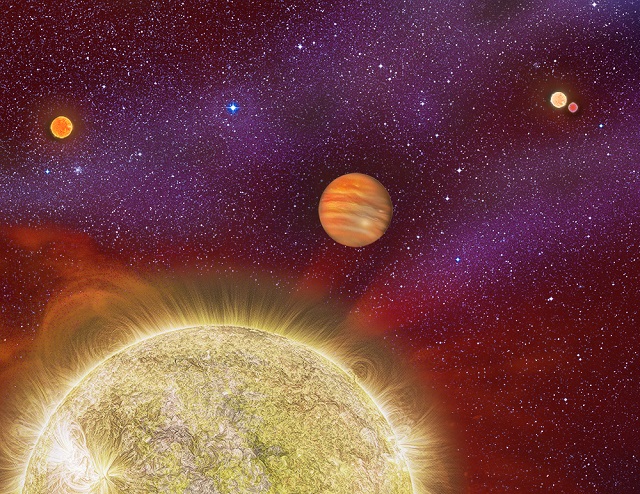
Art by Karen Teramura, UH IfA.
Lo studio, pubblicato su Astronomical Journal, cerca di capire la correlazione tra la presenza di pianeti molto massicci e sistemi stellari multipli. ARI30, a 136 anni luce da noi, nella costellazione dell’Ariete, è il secondo sistema stellare quadruplo ad oggi conosciuto, ma l’ipotesi che non siano una rarità aumenta con l’avanzamento tecnologico.
Che il nostro sistema solare sia una specie di rarità resa meno tale solo dal gran numero di stelle che esistono nell’universo, lo si evince mano mano che gruppi di astronomi rilevano sempre nuove realtà, che ci sarebbe quasi da chiedersi (ma poi in fondo è quella la domanda) come possono comporsi e trovare un equilibrio. E’ questo di fatto il quesito che si sono posti i ricercatori autori di una recente ricerca, pubblicata su Astronomical Journal, che si è avvalsa del Palomar Observatory utilizzando due nuove tecnologie adattive ottiche che compensano gli effetti di sfocatura dell’atmosfera terrestre: il sistema di ottica adattiva Robo-AO robotico, sviluppato sotto la guida di Christoph Baranec della University of Hawaii presso l’Istituto di Manoa per Astronomia, e l’estrema sistema di ottica adattiva PALM-3000, sviluppato da un team di Caltech e Jet Propulsion Laboratory della NASA (JPL), che comprendeva anche Baranec. L’obiottivo era approfondire le conoscenze sulle influenze di più stelle su pianeti extrasolari: e per farlo hanno preso in esame un pianeta in un sistema a quattro stelle, il secondo ad oggi conosciuto. Il sistema, denominato 30 Ari, si trova a 136 anni luce di distanza nella costellazione dell’Ariete. Il pianeta del sistema è un gigante gassoso 10 volte la massa di Giove, che orbita intorno alla sua stella primaria, una piccola nana rossa, ogni 335 giorni, quasi un anno terrestre. Il sistema era già conosciuto ma si riteneva composto di tre stelle: «Circa il 4% delle stelle simili al nostro sole si trovano in sistemi quadrupli, un dato maggiore delle stime precedenti, che è stato reso possibile grazie al miglioramento delle tecniche di osservazione» ha detto il co-autore Andrei Tokovinin del Cerro Tololo Inter-American Observatory in Cile.
Fonte/Leggi tutto → Media.INAF.it
One Planet, Four Stars: The second known case of a planet in a quadruple star system.
Researchers wanting to know more about the influences of multiple stars on exoplanets have come up with a new case study: a planet in a four-star system. The discovery was made at Palomar Observatory using two new adaptive optics technologies that compensate for the blurring effects of Earth’s atmosphere: the robotic Robo-AO adaptive optics system, developed under the leadership of Dr. Christoph Baranec of the University of Hawaii at Manoa’s Institute for Astronomy, and the PALM-3000 extreme adaptive optics system, developed by a team at Caltech and NASA’s Jet Propulsion Laboratory (JPL) that also included Baranec. The newfound four-star planetary system, called 30 Ari, is located 136 light-years away in the constellation Aries. The system’s gaseous planet is enormous, with 10 times the mass of Jupiter, and orbits its primary star every 335 days. The new study, published in the Astronomical Journal, brings the number of known stars in the 30 Ari system from three to four. This discovery suggests that planets in quadruple star systems might be less rare than once thought. “About four percent of solar-type stars are in quadruple systems, which is up from previous estimates because observational techniques are steadily improving,” said co-author Andrei Tokovinin of the Cerro Tololo Inter-American Observatory in Chile. The newly discovered fourth star, whose distance from the planet is 23 times the sun-Earth distance, does not appear to have impacted the orbit of the planet. The exact reason for this is uncertain, so the team is planning further observations to better understand the orbit of the newly discovered star and its complicated family dynamics. Were it possible to see the skies from this world, the four stars would look like one small sun and two very bright stars that would be visible in daylight. If viewed with a large enough telescope, one would see that one of those bright stars is actually a binary system—two stars orbiting each other. In recent years, dozens of planetary systems with two or three host stars have been found, including those that would have twin sunsets reminiscent of the ones on the fictional Star Wars planet Tatooine. Finding planets with multiple stars isn’t too much of a surprise, considering that binary stars are more common in our galaxy than single stars such as our sun.
Source/Continue reading → www.ifa.hawaii.edu
- Leggi anche/Read also:
Astronomi Amatoriali Scoprono Nuovo Pianeta All’Interno di Un Sistema con 4 Stelle! – Tatooine Times Two: Amateur Astronomers Find Planet in Four-Star System - Pianeti orbitanti Stelle Binarie come Tatooine di Guerre Stellari potrebbero ospitare la Vita – Tatooine-Like Alien Planets Could Host Life
- Vita Extraterrestre potrebbe comunemente trovarsi intorno a stelle binarie – Extraterrestrial Life May be Common Around Binary Stars





















